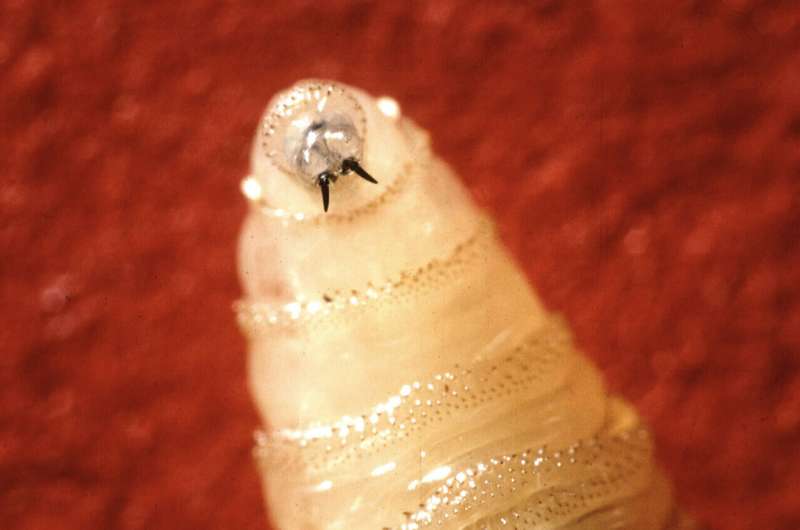In an unprecedented move, the U.S. government is preparing to breed billions of sterile flies to be released over Mexico and southern Texas, aiming to combat a flesh-eating maggot that poses a significant threat to the nation’s beef industry, wildlife, and even household pets. This innovative approach, which might sound like a plot from a science fiction movie, is a strategic effort to protect the U.S. from the New World Screwworm fly, a pest that has been successfully eradicated in the past using similar methods.
The U.S. Department of Agriculture (USDA) plans to scale up the breeding and distribution of adult male flies, sterilizing them with radiation before release. This method is designed to ensure that these sterile males mate with females, leading to a gradual decline in the pest population. This approach is considered more environmentally friendly and effective than traditional pest control methods like spraying.
The Science Behind Sterile Insect Technique
Edwin Burgess, an assistant professor at the University of Florida who specializes in animal parasites, describes the sterile insect technique as an “exceptionally good technology.” He notes, “It’s an all-time great in terms of translating science to solve some kind of large problem.” The New World Screwworm fly, the target of this operation, is notorious for its flesh-eating larvae, which can devastate livestock and wildlife.
The USDA’s plan involves setting up a new screwworm fly factory in southern Mexico by July 2026, with a distribution center in southern Texas expected to be operational by the end of the year. This will facilitate the import and distribution of flies from Panama, where a factory has been containing the pest for years.
The Threat of the New World Screwworm Fly
Unlike most fly larvae, which feed on dead tissue, the larvae of the New World Screwworm fly consume live flesh, making them particularly dangerous. Female flies lay their eggs in wounds or exposed mucous membranes, leading to severe infestations. Michael Bailey, president-elect of the American Veterinary Medicine Association, warns, “A thousand-pound bovine can be dead from this in two weeks.”
While veterinarians have effective treatments for infected animals, the process is both unpleasant and painful for the affected livestock. Don Hineman, a retired Kansas rancher, recalls the pungent odor of infected cattle from his youth, describing it as “like rotting meat.”
Biological Advantage in Pest Control
The New World Screwworm fly is a tropical species, unable to survive the harsh winters of the Midwest or Great Plains, which historically limited its range. From 1962 to 1975, the U.S. and Mexico released over 94 billion sterile flies to eradicate the pest. The key to success lies in the fly’s mating habits: females mate only once in their lifetime, allowing the release of sterile males to effectively control the population.
“The numbers need to be large enough that females in the wild can’t help but hook up with sterile males for mating,” explains Burgess.
Strategic Expansion and Challenges
Alarmed by the fly’s northward migration, the U.S. temporarily closed its southern border to imports of live cattle, horses, and bison in May, a measure expected to last until mid-September. The USDA aims to increase its capacity to breed flies, planning to invest $8.5 million in the Texas site and $21 million in converting a facility in southern Mexico.
Cassandra Olds, an assistant professor of entomology at Kansas State University, notes that while raising large colonies of flies is relatively straightforward, it requires precise conditions. “You’ve got to give the female the cues that she needs to lay her eggs, and then the larvae have to have enough nutrients,” she explains.
Logistical and Safety Considerations
Dropping flies from airplanes is not without risks. A recent accident near Mexico’s border with Guatemala resulted in the tragic loss of three lives. Historically, the USDA used paper cups and special chutes to release flies, later transitioning to crates dropped from light planes. This method, developed in the 1950s and 1960s, is still in use today and is considered one of the USDA’s “crowning achievements.”
Sonja Swiger, an entomologist with Texas A&M University’s Extension Service, emphasizes the importance of security at breeding facilities to prevent fertile adults from escaping.
Looking Ahead
As the USDA moves forward with its plans, some agriculture officials advocate for maintaining the new factories even after the current threat subsides. “Something we think we have complete control over—and we have declared a triumph and victory over—can always rear its ugly head again,” warns Burgess.
This proactive approach reflects a broader understanding of the complexities of pest management and the necessity of maintaining vigilance against potential threats to agriculture and biodiversity.
